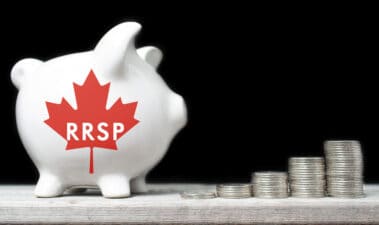We do a lot of recommending here at the Motley Fool Canada. But another thing that the company is known for is education. That’s why I came here in the first place: to start learning not just where to invest, but why.
So I’ve started digging into the basics of investing, and that’s when I started looking into compound annual growth rate, or CAGR. This can be an ideal tool for investors to determine whether it’s worth it to invest in a stock or wait for a turnaround. So below, I’ll give you the basics of what CAGR is, what it can tell you, and an example of where it might be useful with a company like Bombardier Inc. (TSX:BBD.B).
What is CAGR?
CAGR pretty much tells you what shares have done in a certain period. Usually, you’ll see investors looking at five- 10- or 20- year periods. It’s an accurate and easy way to calculate and determine the returns of any investment to see if it’s risen or fallen in that time.
The math, as I said, is simple. Let’s say you’re looking at the last five years of a company. You simply today’s value of a stock, subtract the price of that stock at the same time five years ago, and divide by the last share price. Then, multiply by 100 to get the percentage, and then divide by the years. In this case – again – five. Let’s say you had shares at $100 in value, and five years ago it was $50 in value. That would be $100, subtract 50, divided by 50, multiplied by 100, and divided by five. That equate to a CAGR of 20% in the last five years.
What can CAGR tell you?
Let’s start with what CAGR can’t tell you. It can’t tell you how a stock will absolutely perform. It can’t tell you if a stock is risky or not. What it can tell you is how a stock performed in the past. This can be incredibly beneficial for stocks that are in a stable industry, and especially for blue-chip stocks. These stocks are large businesses that are unlikely to waiver all that much except in a recession. So, it’s a beneficial tool to tell you whether you should dig further into a stock.
Let’s say you have a company that was doing well, then suddenly dropped. Let’s say the 10-year CAGR was 15%, but if you look at the five-year CAGR, it’s -5%. Suddenly, it doesn’t look like a great investment.
That leads me to my example of Bombardier. The company hit its heights at $26 per share around the turn of the century. So investors are likely wondering whether it can reach that share price again. They are also wondering if they will double or triple their investment. After all, the stock currently trades at $0.34 per share, so that seems likely, doesn’t it?
But if you look at its CAGR, it’s a different story. Bombardier has a five-year CAGR of -14.7% and a 10-year CAGR of -9.3%. So it’s been over a decade since the company made any positive movement. Even with other companies rebounding, Bombardier is still low. If there’s a decade of bad news, it’s incredibly risky to think Bombardier will suddenly turn around.
Bottom line
CAGR is a fantastic way to start your research into any stock. You can see how a company has been performing on average over years, rather than since one or two drops or surges in share price. Once you see that a company has been growing steadily, you can start your research into whether it should be added to your watch list.






